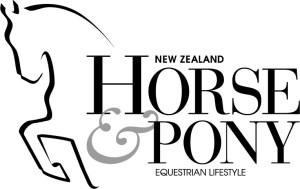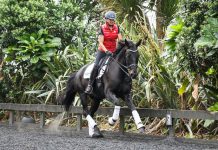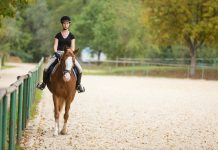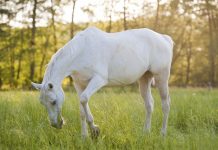
While a lot of research, care and attention is directed to the supplementary feed we give to our horses, the pasture they graze is often ignored.
But a paddock is not just to give a horse sunshine and exercise, it is where a horse should get the bulk of its nutrition. Grass is an essential part of a horse’s diet, and is even more important than the grain supplements you provide. After all, the horse evolved to consume and digest grass, and supplementary feeds should be just that – supplementary – given to keep a hard-working horse in peak condition.
For gastrointestinal health, horses need to eat about 1% of their body weight in hay or pasture grasses daily (4.5kg of dry matter intake for a 450kg horse).
Substituting insufficient pasture with grain-based feed is like withholding fruit and vegetables from your children and giving them sugary cereals instead. It will directly affect the both their overall health and their immediate behaviour.
Insufficient and incorrect pasture can be the difference between a problem horse and a calm and responsive animal. Inadequate pasture can be responsible for head-flicking, wind-sucking, inflammations (including laminitis), reproduction issues and a range of other behavioural and health issues.
In contrast, good pasture has a cooling, calming affect on a horse’s temperament and can give your horse all the nutrition it needs to be healthy and focused.
Unfortunately, neglect and overgrazing often means our pasture is not good quality.
Quality pasture can only come from quality soil. You cannot run a race car on inferior petrol, nor grow good grass on bad soil. If you want your pasture to provide nutrients to your horse, those nutrients must be available from the soil.
A basic soil test costs about $80 and gives you the levels of the major elements, but ignore the optimum results they graph. These ranges are for the growth of ryegrass and clover – good grasses for putting weight on cattle, but not for healthy horses. The result of most interest to horse owners is the pH, and this can also be tested yourself with a cheap soil test kit available from a garden nursery.
The pH is the level of acidity; if your soil is too acidic, nutrients and other elements in your soil are locked up – bound tightly to other particles and unavailable to the plants. For horse grasses, the pH should ideally be between 6 and 6.2.
You can raise the pH level quite quickly by applying a lime-based fertiliser. Agricultural lime is quite cheap and can be purchased from most rural supplies stores or a fertiliser company. Dolomite is natural product containing both the calcium in lime and magnesium – and since the two elements are linked, I prefer to use this. Also available is a product called Equi-lise which is calcium, magnesium and a few other elements to suit horse pasture.
These can be spread by hand, through a spreader towed behind a quad bike or by a contractor with a truck.

The exact amount of lime you spread is not especially important. Each type of lime will come with a recommended rate – 2.5tonnes of agricultural lime per hectare should raise your pH by 0.3 units – but adjusting your soil cannot be done instantly and additions are best applied a little and often. Spread some, test again in six months and reapply if necessary.
When testing your soil, choose a paddock that hasn’t been grazed for while (so is not affected by fresh urine patches) and select samples from areas away from fences, gates, feed bins or troughs. Note how moist the ground is and when repeating soil tests, try to do so in similar conditions – preferably when not too dry.
An underground desert?
More important than a chemical analysis is the physical structure and microbiological life in the soil. Nutrients are captured, made and converted by living organisms in soil. Don’t underestimate the amount of life that should be present underground – to support a 500kg horse above the ground, there needs to be at least 500kg of soil life under the ground. Most of this we cannot see with the naked eye – fungi, bacteria, nematodes, protozoa… there are many, they are diverse and their roles are complex.
At the top of this subterranean food chain are worms. If you dig a hole on a warm, damp day and don’t see any worms, your soil is a literally an underground desert. While the ideal and oft-quoted count of 30 worms per spadeful is more often seen in your compost pile than your paddock, a count of how many worms you have gives a good indication of how healthy your soil is. And if your soil’s not healthy, your grass (and your horse) will be lacking.
Worms indicate the presence and health of subterranean life, and are constantly adding beneficial vermicast and improving the structure of your soil.
A quick way to jump-start soil life is to inoculate your paddocks with a range of beneficial organisms. This is not essential, as in the right conditions it will be colonised naturally, but spreading compost on your paddocks can give almost instant results. Good compost can be purchased commercially, and contains a wide range and good quantity of bacteria and fungi as well nutrients and the organic matter for microbe food.
Vermicast is also a high-value quick start with worm eggs amongst the nutrients, and EM (short for effective microorganisms) is just one of a range of liquid microbial inoculants that you can buy and apply easily through a sprayer (make sure it has been well cleaned of any weed sprays). Consider all of these as ‘seeds’ of soil microbes – a bit like taking probiotics for your gut health.
top tip: Lime and inoculants are best applied when the soil is damp and the pasture is being rested from grazing.
Sustaining soil life
The methods to increase and sustain soil life are as complex, and almost as interesting as training a horse, but the basics are constant. Soil life requires air, moisture, good food and a safe habitat to flourish and perform.
All soil life and plant roots require air, and worms burrow macro-pores through the soil that allows water and air to flow. Heavily compacted soils – especially around high traffic areas or where animals stand in winter – struggle to grow grass.
Reduce any machinery unnecessarily driving on the grass, especially in winter. Move feed bins regularly so one area isn’t getting trampled up. Add drainage. Have a dryish sacrifice paddock or race to use during wet periods. In all, do whatever you can to prevent pugging and soil compaction.
Most important to soil life is constant food. Food for soil microbes is organic matter. Bacteria and fungi, which are the start of the food chain, feed on rotting vegetation and manure. If a paddock is continuously grazed hard, and the manure collected and removed, there is simply no food for the soil microbes.
When microbes are starved, an observant eye will notice changes within a few seasons. The grass sward is not as thick, there are more weeds, the grass dries out quicker in summer, pugged areas are larger in winter… Other changes can take years and even generations to become noticeable, and those changes can take considerable effort to reverse.
Feeding your soil life is indirectly feeding your horse, though sometimes it is actually the other way around. If you buy in hay from off the property, you are bringing nutrients on to the property – via your horse’s manure.
Removing manure from the paddock removes food from the soil micro-organisms, though of course, it does break the parasitic worm cycle.
Pile the manure you remove up in layers with old hay, straw, wood shavings, twigs etc until it turns to compost (this takes about a year, and any parasites are well dead by then). Spreading it back on the paddock as compost is one way to get the benefits of the organic matter without contaminating your paddocks.
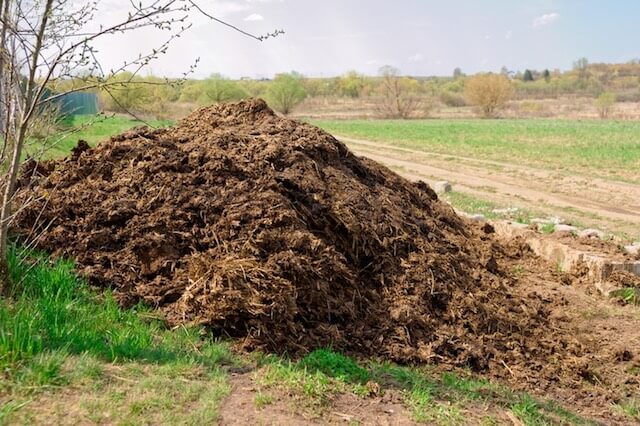
You can also buy in nutrients like fish fertiliser to feed your soil life, and this has the added benefits of introducing trace elements.
Trace elements don’t show on a soil test, and are not even fully understood, but work in complex relationships on the soil life, plant health and animal health. While some areas in New Zealand are noted for severely lacking certain elements (selenium, boron or cobalt, for instance) just about every area can do with a boost, and seaweed fertiliser provides a balanced source of a wide range of elements. Seaweed can be added to your compost pile and then spread, soaked in water and sprayed (this ‘tea’ can also be purchased ready-made) or simply given to the animals to eat, who will defecate excess on to the pasture.
Harrowing, farrowing and mowing
Harrowing in hot, dry weather can expose any parasites to heat and air (conditions they don’t like) and spreads out the manure for the worms. The newly-introduced to New Zealand dung beetles are another way to get the manure into the soil quickly.
Farrowing is an age-old method of supplying organic matter to your soil, and was traditionally done every seven years (ie. rest one-seventh of your pasture each year over a seven-year cycle).
In my case, I simply take a paddock out of rotation in spring when I have excess grass, leave it to grow and seed in autumn, then graze it again during the winter shortage so it is ready to burst forth the following spring with new growth. In the case of a bad drought I can bring it back into rotation if feed is scarce, so it is also acts an a reserve for emergencies.
This schedule works best if you have mild summers with low fire risk and a good pasture sward to provide desirable seed. It also has the added advantage of crowding out many weeds. Depending on your climate (and fire risk) it may suit you better to fallow over winter, but whichever way, fallowing has multitude benefits, not just boosting the soil life also providing habitats for huge range of beneficial insects and food for birds, and cleanses your paddock of parasites and other diseases.
Mowing a paddock immediately after grazing tops undesirable pasture species, and so prevents them from becoming dominant, and turns your weeds into worm food. Mowing Californian thistles in the rain introduces a fungal disease to the stem, which can kill the plant. Unfortunately, this method does not seem to be effective to control dock, though it does reduce it seeding.

Mow the paddock on the highest setting possible on your mower, as you want to top the weeds, not shorten the grass. Be careful using ride-on mowers on uneven ground.
Just as important as food is a safe and secure habitat for the soil life. This means not killing them with chemicals. The majority of soil life is fungal, so any sort of fungicide sprayed on your paddocks is going to negatively affect it. Insecticides obviously kill insects, herbicides might kill the weeds, but can also affect the soil life that eats the poisoned weed. Even dewormers administered to the horses will affect the worms that eat the manure.
While this can pose challenges on how to deal with unwanted organisms originally, over time nature will balance itself out and the ‘good’ fungi, bacteria and insects will control the ‘bad’. Meanwhile, keep contaminated manure separate, as it will take longer to compost.
Diversity is key
Good pasture contains grass species suitable for your horse and as with your soil life, diversity is the key. Take your horse for a walk in-hand, allow them to browse and note what they choose. The range is diverse and includes strange (to us) things like thistle flowers and tree bark.
Just as you like variety in your vegetables so does a horse, and different pasture species grow at different rates, in different seasons or conditions and provide different nutrients. The more diversity the better.
Horse have evolved to eat a high-fibre diet, and common New Zealand pasture – particularly in the warmer northern climates – are low fibre, high-sugar grasses that can even be detrimental to your horse. Rye grass and clover mix, desired for weight gain and milk production in cattle, can be the cause of laminitis, staggers or heat stress in horses.
Most seed merchants sell a special seed mix for horses. This contains high-fibre, balanced-sugar grasses like cocksfoot, fescue, timothy grass, lotus, brown top, prairie grass, fog grass, crested dogs tail and grazing brome.
I have also trialled mustard (supposedly this can ‘sanitise’ the pasture), oats and barley. I am not too sure if any soil pasteurising got done as the horses simply ate these species out as soon as they got access! They certainly enjoyed them and I am sure the diversity was beneficial, but they did not persist with grazing and were probably not value for money.
Herbs are also beneficial, but often do not survive regular grazing. Yarrow, which is beneficial for its circulatory properties, grows well amongst my pasture in the Waikato, but herbs like fennel, wormwood, thyme, rosemary and so on. need to be planted behind a netting fence so only the growing tips can be nibbled.
Flaxes, tree leaves and bark and seed heads are also enjoyed by horses.
When to sow
Sow grass seeds in autumn, when the ground is wet but still warm. A spring sowing can be done, but is not usually as effective as the natural timing of autumn seeding.
Sow on to short pasture that has just been grazed. Grass seed needs to make contact with the soil. Sowing can be as simple as walking around and casting the seed by hand, with a little spreader that can often be borrowed or hired from your seed merchant, or by a contractor who can also direct sow if preferred.
Don’t graze until the new grass is well established, and certainly not before it passes the tug test: tug a new grass plant as a horse would when eating, and ensure the roots are strong enough to stay firmly in the ground.
Maintaining your pasture requires ongoing management and correct stocking rates. Grass requires some recovery time after grazing, and horses do better on mature, nutrient-dense grass than the lush new growth in spring and autumn. It is during these high-growth periods you should feed your horse fibrous hay and restrict their access to the newly-grown grass, allowing the grass to mature into a nutritious feed, establish a robust root system to enable quick regrowth and to allow some roots and grass to die off into organic matter to feed the soil life.
Control your stocking rate so you can rest a paddock 20 – 90 days between grazings. If you have the capacity, cross-grazing with sheep immediately after your paddock has been grazed by horses will control both unwanted weeds (ie. dock and buttercup) and parasites.
The longer you can leave a paddock to regenerate after grazing, the better for the nutritional value of grass for the horse, strength of the pasture sward and health of soil life.
About the author
Sheryn Clothier edited the NZ Tree Crops Assn Journal for 11 years, and writes now for a variety of magazines including NZ Lifestyle Block. She and her husband Steven have 3.5ha in Tirau, which they have transformed over 10 years from a rundown and boggy dairy farm into an organic and sustainable block with more than 300 different fruits, nuts and berries

- This article was first published in the May 2019 issue of NZ Horse & Pony. Click here to subscribe

